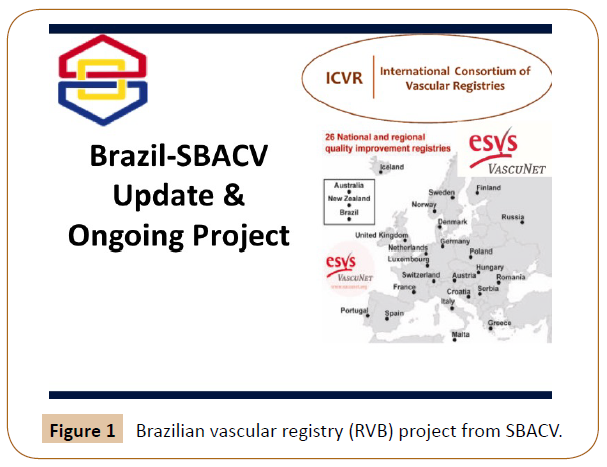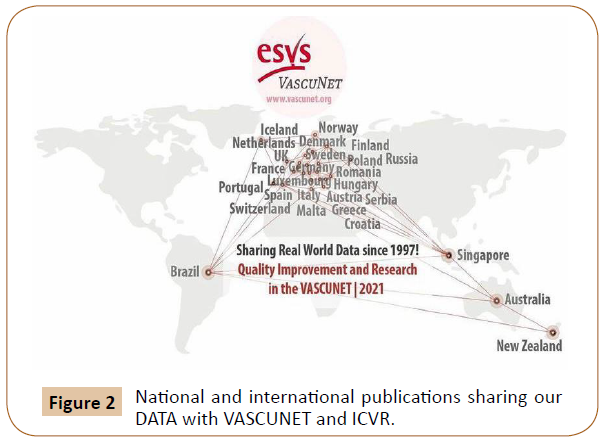Brazilian Vascular Registry is Born
Paulo Eduardo Ocke Reis and Daniel Mendes Pinto
DOI10.36648/2634-7156.21.6.26
Paulo Eduardo Ocke Reis1* and Daniel Mendes Pinto2
1Department of Specialized and General Surgery, Fluminense Federal University, Rio de Janeiro, Brazil
2Hospital Felicio Rocho, Belo Horizonte, Brazil
- *Corresponding Author:
- Paulo Eduardo Ocke Reis
Department of Specialized and General Surgery, Fluminense Federal University, Rio de Janeiro, Brasil
Tel: +55 21 2629-5000
E-mail: vascular@pauloocke.com.br
Received Date: May 28, 2021; Accepted Date: June 15, 2021; Published Date: June 30, 2021
Citation: Reis PEO, Pinto DM (2021) Brazilian Vascular Registry is Born. J Vasc Endovasc Therapy Vol.6 No. 6: 26.
Abstract
Editorial
Clinical leadership and knowledge of the specialty must be a key point / mandatory so that in the future we can be fully involved in this process and offer the best treatment to our patients. The skills and culture for said clinical leadership need to establish and organize collaboration of vascular registries leading to quality improvement [1,2]. It can be challenging to start a national registry, but lessons from Vascunet countries suggest that we can start with limited data collection for 4-5 treatment types and expand this gradually [2,3]. Surgeons are keenly interested in benchmark reports that anonymously compare their results with others, since they all want to see what and how they can improve [2,3].
So, how to get on it? Over the last years, we were excited to be participating in the critically important program, which will define real world outcomes for patients with vascular disease [1,2]. My desire begin to grow up, to be able to participate and help to organize the participation of Brazil and eventually of South America in the Vascunet and ICVR (International Consortium of Vascular Surgery Registries) [4]. With the initiative of the Brazilian Society of Angiology and Vascular Surgery (SBACV), a national committee was first created by members of our national society to begin a pilot study. We propose the creation of the Brazilian Vascular Registry (RVB) project. It has the objective of registering quality improvement in Brazil, beginning with five institutions and four pathologies: Aortic aneurisms, carotid disease, peripheral arterial disease, and amputations [5] (Figure 1).
RVB
Main Objective
• To catalog the procedures of the specialty of Vascular Surgery performed by vascular surgeons associated with SBACV in the participating centers in Brasil.
• Secondary Objectives-
• To establish a database of vascular procedures selected by the RVB Project group.
• To organize data to serve as a subsidy for guidelines guided by SBACV.
• National and International publications sharing our DATA with VASCUNET and ICVR (Figure 2).
There is no individual or direct benefit of the research participant. The benefit could be classified as diffuse and indirect, as it has positive consequences for the community, especially for specialists in Vascular Surgery. The potential benefits are:
• Epidemiological identification of the types of vascular surgery procedures performed in our country.
• Improvement of specialized assistance in Vascular Surgery through the knowledge in the specialty.
• Establishment of performance objectives by SBACV that can serve as indicator goals in our institutions.
All these require organization, hard work, and persistence and focused thinking. Finally it will help us disseminate and update knowledge and advances in our specialty so that all vascular surgeons and others can practice the best most up-to-date effective and justified care for our patients [1-6].
References
- Ocke Reis PE (2017) Building the future in Vascular Surgery. J Vasc Endovasc Surg 2: 1.
- Ocke Reis PE, Cronenwett JL (2018) Opportunities in the international Consortium of Vascular Registries. J Vasc Endovasc Therapy 3: 24.
- Mitchell D, Venermo M, Mani K, Bjorck M, Troëng T, et al. (2015) Quality improvement in vascular surgery: The role of comparative audit and vascunet. Eur J Vasc Endovasc Surg 49: 1-3.
- Behrendt CA, Venermo M, Cronenwett JL, Sedrakyan A, Beck AW, et al. (2019) VASCUNET, VQI and the International Consortium of Vascular Registries-unique collaborations for quality improvement in vascular surgery. Eur J Vasc Endovasc Surg 58: 792-793
- Behrendt CA, Bertges D, Eldrup N, Beck AW, Mani K, et al. (2018) International Consortium of Vascular Registries consensus recommendations for peripheral revascularization registry data collection. Eur J Vasc Endovasc Surg 56: 217-237.
- Veith FJ, Ocke Reis PE (2019) Energy level: an important determinant of success in vascular surgery. J Vasc Bras 18: e20190029.
Open Access Journals
- Aquaculture & Veterinary Science
- Chemistry & Chemical Sciences
- Clinical Sciences
- Engineering
- General Science
- Genetics & Molecular Biology
- Health Care & Nursing
- Immunology & Microbiology
- Materials Science
- Mathematics & Physics
- Medical Sciences
- Neurology & Psychiatry
- Oncology & Cancer Science
- Pharmaceutical Sciences


